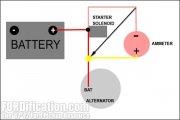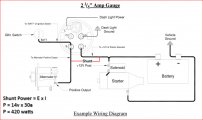FishFry
Active Member
Did a 12 volt conversion to my 41, and want to keep the original ammeter.
And yes I know - volt gauge would be better/your car will be on fire etc. - I discussed this ad nauseam, and I understand it.
Point is: I'm not just throwing in a 3 wire alternator and call it a day, I make a complete new harness, since the old one is a mess of a spaghetti monster anyway.
I got an 10 gauge wire going from the alternator to the buss bar (my starter in that case) acting as some kind of shunt that takes most of the load, and "splice" the ammeter in like in this diagram I found.
Does that diagram make any sense to somebody who is more electric savvy then me?
Thanks, Frank
And yes I know - volt gauge would be better/your car will be on fire etc. - I discussed this ad nauseam, and I understand it.
Point is: I'm not just throwing in a 3 wire alternator and call it a day, I make a complete new harness, since the old one is a mess of a spaghetti monster anyway.
I got an 10 gauge wire going from the alternator to the buss bar (my starter in that case) acting as some kind of shunt that takes most of the load, and "splice" the ammeter in like in this diagram I found.
Does that diagram make any sense to somebody who is more electric savvy then me?
Thanks, Frank




